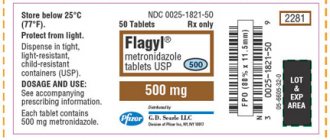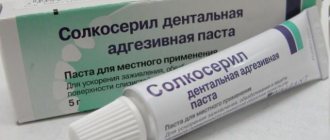Tiklid (Ticlopidine) 250 mg tablet. No. 30 - Instructions
Compound
The active substance is ticlopidine hydrochloride.
Other Ingredients:
- base: microcrystalline cellulose, corn starch, polyvidone, citric acid, magnesium stearate, stearic acid;
- Coating: hydroxypropyl methylcellulose, titanium dioxide and polyethylene glycol 8000.
Release form
The drug is in the form of tablets placed in packages of 30 pieces.
pharmachologic effect
Ticlopidine blocks platelet aggregation, slowing down the ADP-dependent synthesis of fibrinogen membranes and platelets. In addition, the ingredient does not slow down the action of COX, which distinguishes it from aspirin. Plaque-associated cyclic AMP does not appear to be involved in the therapeutic effect of ticlopidine.
The bleeding period at a pressure inside the cuff is 40 mmHg. (measured by the Ivey method) is more than twice the baseline value. The prolongation of bleeding is less pronounced if it occurs without the use of a blood pressure cuff.
In most patients, bleeding time and other platelet function data stabilize within 7 days after discontinuation of the drug. [3]
The development of the effect of inhibiting platelet aggregation is observed 2 days after the start of taking ticlopidine twice a day. The substance reaches its maximum effect on days 5-8 of therapy, when 0.25 g of the drug is used 2 times a day.
At a therapeutic dose, ticlopidine suppresses ADP-dependent platelet aggregation (2.5 µmol/l) by 50-70%. Small doses lead to proportionally less suppression of this process.
Pharmacokinetics
After using the first standard dose of the drug, rapid and almost complete absorption is observed. The substance reaches Cmax in plasma after 2 hours.
The optimal level of bioavailability of the drug is observed when it is consumed after meals.
Stable levels in blood plasma are observed after 7-10 days of therapy using a double amount of 0.25 g per day. The half-life of ticlopidine at constant rate is approximately 30-50 hours. But suppression of platelet aggregation is not related to plasma drug levels.
Most of ticlopidine is involved in intrahepatic metabolic processes. After consuming a radioactive substance, about 50-60% of the radioactivity is fixed in the urine, and another 23-30% in the feces.
Indications for use
Ticlid is used to prevent complications of blood clotting in the arteries (myocardial infarction with stroke and vascular death) in people who have had their first stroke due to atherosclerosis.
It is prescribed for the prevention of serious ischemic complications, especially of the coronary type, in people with an obstructive form of atherosclerosis (chronic), with affected legs and diagnosed with intermittent claudication.
The medication is also used to prevent relapse of thrombosis of arteriovenous fistulas during long-term hemodialysis.
Contraindications
Absolute restrictions:
- diathesis of hemorrhagic type;
- organic lesions causing bleeding: active stage of hemorrhagic stroke or acute ulcer;
- blood diseases that cause a prolonged period of bleeding;
- a history of allergic symptoms associated with ticlopidine;
- history of hematological disorders (thrombocytosis or leukopenia and agranulocytosis).
Side effects
Possible side effects include:
Hematological pathologies:
There are studies that have reported neutropenia; individually, this disorder resulted in death.
Hematological disorders often develop during the first 3 months of therapy and are usually asymptomatic. For this reason, it is necessary to constantly monitor hematological parameters. When disorders occur, there is usually a decrease in the number of bone marrow precursors in the bone marrow.
Other hematological disorders include:
- bone marrow aplasia or pancytopenia;
- isolated thrombocytopenia or in combination with hemolytic anemia;
- TTP for hemolytic anemia, thrombocytopenia, renal failure, neurological disorders and fever.
Hemorrhagic symptoms:
During the entire period of treatment, hemorrhagic complications of varying severity may occur. They can last up to 10 days after stopping treatment and lead to pre- and postoperative bleeding.
Disorders associated with the digestive tract
Among them are nausea and diarrhea. Typically, such symptoms appear at the initial stage of therapy and disappear after 7-14 days. But if such violations are regular and severe, therapy is stopped.
Occasionally, severe diarrhea is observed, accompanied by inflammation of the colon (mainly lymphocytic form).
Rash (urticaria or maculopapular rash, often itchy).
The rash usually appears within the first 7 days of treatment. These symptoms disappear within a few days after stopping treatment. The rash may be generalized. Erythema multiforme is recorded individually.
Allergy symptoms
Diseases such as angioedema, vasculitis, anaphylactic symptoms, allergic nephropathies, lupus syndrome, fever and allergic pneumopathy are rare.
Liver dysfunction
Occasionally, cholestatic or cytolytic forms of hepatitis occur (in the first months of therapy). After stopping Tiklid, the course of the pathology has a positive prognosis. But sometimes there were deaths.
Biological (non-hematological) disorders
Liver diseases.
Isolated or associated increase in transaminases, alkaline phosphatase and bilirubin in the first 4 months of therapy.
Blood lipids.
Levels of HDL cholesterol, LDL cholesterol, and serum triglycerides and VLDL cholesterol may increase by 8-10% within 1-4 months of treatment without further progression with continued treatment. Lipoprotein ratio levels (especially HDL/LDL) do not change.
Compatibility with other medications
Some drugs may interact with medications depending on their antiplatelet activity. Among them: NSAIDs, tirofiban and aspirin with eptifibatide, abciximab, iloprost and clopidogrel.
The combination of several substances that slow down platelet aggregation and the use of drugs together with oral anticoagulants, heparin and thrombolytics can significantly increase the likelihood of bleeding, so constant biological and clinical monitoring of the patient's condition is carried out.
Aminophylline and theophylline (salts and bases).
It is possible that the level of theophylline in plasma may increase, and there is a possibility of intoxication (decreased clearance of theophylline in plasma). The patient should be under clinical observation with recording of plasma theophylline levels. If necessary, the dose of theophylline is adjusted during treatment with ticlopidine and at the end of treatment with ticlide.
Fosphenytoin with phenytoin.
An increase in the plasma phenytoin index can occur with symptoms of intoxication (inhibition of the metabolic processes of phenytoin). Clinical monitoring of the patient's condition and the level of phenytoin in the blood plasma is necessary.
Cyclosporine.
There is a decrease in the level of cyclosporine in the blood. It is necessary to increase the dose of cyclosporine and monitor its level in the blood. After discontinuation of ticlopidine, the dose may be reduced.
Application and dosage
The drug is taken orally for all indications - 2 tablets per day with meals. The duration of therapy is chosen by the attending physician.
Overdose
Information from animal studies indicates that severe gastrointestinal hypersensitivity may occur in cases of Ticlid poisoning.
If necessary, careful monitoring of basic hemostasis data and body condition is carried out. In case of poisoning, it is necessary to induce vomiting. Symptomatic actions are performed.
special instructions
At the beginning of treatment, a complete blood count should be performed along with a smear, as well as a determination of platelet levels. These tests should be performed every two weeks for the first three months of treatment, and within 15 days after stopping treatment if it is necessary to stop treatment during the first three months of treatment.
If the neutrophil count falls below 1500/mm3, the test should be repeated to confirm the results. In case of neutropenia, that is, a decrease in the number of neutrophils below 1500/mm3, as well as thrombocytopenia, that is, a decrease in the number of platelets below 100,000/mm3, treatment with Tiklid should be strictly discontinued.
Use during pregnancy and breastfeeding
There is currently no information to determine the likelihood of developmental abnormalities or fetotoxicity of ticlopidine when used in pregnant women. For this reason, Tiklid is not prescribed within the prescribed period.
Ticlopidine passes into breast milk and is therefore not used during breastfeeding.
Impact on the ability to drive vehicles and operate machinery
No special precautions are required.
Terms of sale
As prescribed by the doctor.
Storage conditions
In a dry, cool place with limited access for children.
Description of the drug RIVAXAN
Concomitant use of rivaroxaban and strong inhibitors of the isoenzyme CYP3A4 and P-glycoprotein may lead to a decrease in renal and hepatic clearance and thus significantly increase the AUC of rivaroxaban.
The combined use of rivaroxaban and the azole antifungal drug ketoconazole (400 mg 1 time / day), which is a strong inhibitor of CYP3A4 and P-glycoprotein, led to a 2.6-fold increase in the average steady-state AUC of rivaroxaban and a 1.7-fold increase in the average Cmax of rivaroxaban, which is accompanied by a significant increase pharmacodynamic effects of the drug.
With simultaneous use of rivaroxaban and the HIV protease inhibitor ritonavir (600 mg 2 times / day), which is a strong inhibitor of CYP3A4 and P-glycoprotein, led to a 2.5-fold increase in the average steady-state AUC of rivaroxaban and a 1.6-fold increase in the average Cmax of rivaroxaban, which is accompanied by a significant enhancing the pharmacodynamic effects of the drug. Therefore, rivaroxaban should be used with caution when treating patients concomitantly receiving systemic azole antifungals or HIV protease inhibitors.
Clarithromycin (500 mg twice daily), a potent CYP3A4 inhibitor and moderate-intensity P-glycoprotein inhibitor, caused a 1.5-fold increase in mean AUC values and a 1.4-fold increase in Cmax of rivaroxaban. This increase in AUC and increase in Cmax are within normal limits and are considered clinically insignificant.
Erythromycin (500 mg 3 times/day), a moderate inhibitor of CYP3A4 isoenzyme and P-glycoprotein, caused a 1.3-fold increase in the mean steady-state AUC and Cmax values of rivaroxaban. This increase in AUC and increase in Cmax are within normal limits and are considered clinically significant.
Co-administration of rivaroxaban and rifampicin, a potent inducer of CYP3A4 and P-glycoprotein, resulted in an approximately 50% decrease in the mean AUC of rivaroxaban and a parallel decrease in its pharmacodynamic effects. Concomitant use of rivaroxaban with other strong CYP3A4 inducers (eg, phenytoin, carbamazepine, phenobarbital or St. John's wort) may also result in decreased plasma concentrations of rivaroxaban. The decrease in plasma concentrations of rivaroxaban is considered clinically insignificant.
After the combined use of enoxaparin (in a single dose of 40 mg) and rivaroxaban (in a single dose of 10 mg), an additive effect was observed regarding the activity of antifactor Xa, which was not accompanied by additional effects regarding blood coagulation parameters (prothrombin time, aPTT). Enoxaparin did not change the pharmacokinetics of rivaroxaban.
There was no pharmacokinetic interaction between rivaroxaban and clopidogrel (loading dose of 300 mg followed by a maintenance dose of 75 mg), but in a subgroup of patients a clinically significant increase in bleeding time was detected, which did not correlate with platelet aggregation and P-selectin or GPIIb/IIIa receptor levels .
No clinically relevant prolongation of bleeding time was observed after coadministration of rivaroxaban and 500 mg naproxen. However, a more pronounced pharmacodynamic response is possible in some individuals.


